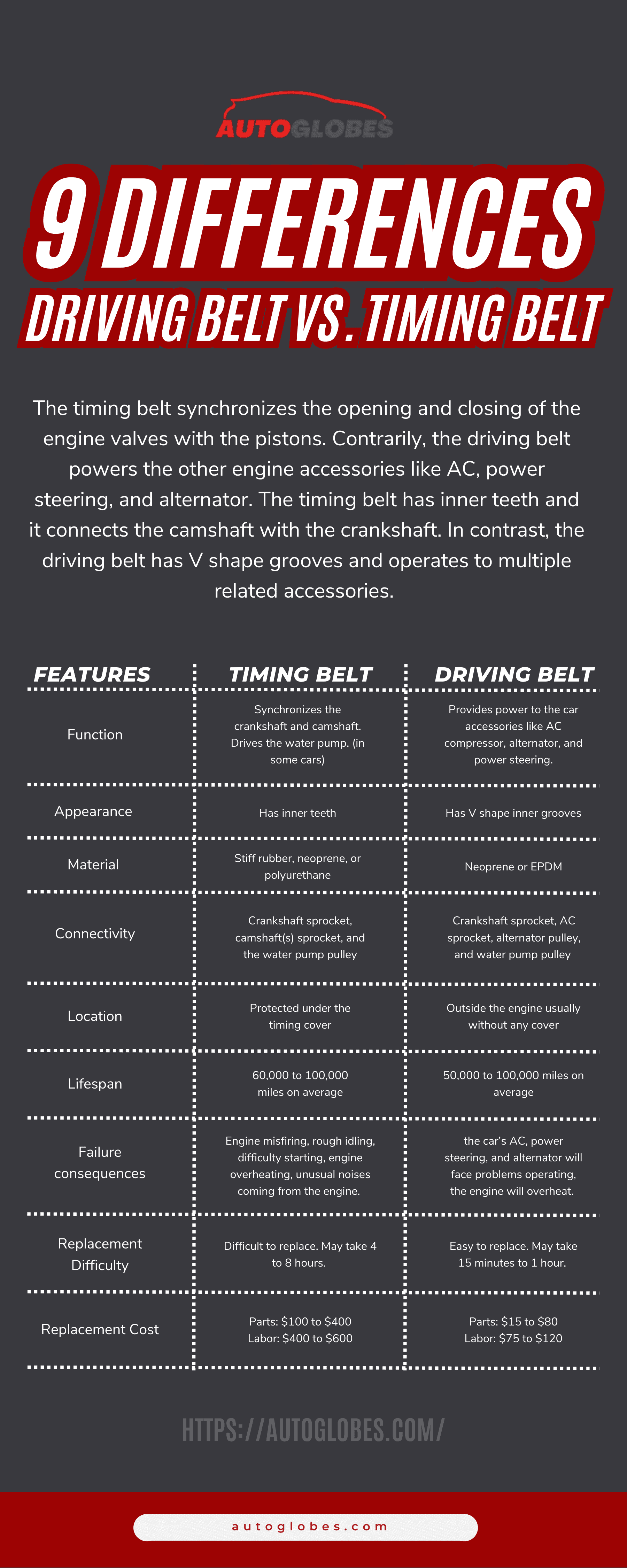It is critical to keep your vehicle running smoothly at all times, which involves performing regular maintenance. Timing belts and drive belts, which are involved in the smooth operation of your car, play a vital role. If you’ve ever wondered about the differences between these two belts, you’re not alone. Let’s dive deeper into the realm of timing belts versus drive belts to unravel their distinctions.
Timing belts and drive belts are not interchangeable and each type has its function and role in maintaining optimal engine performance.

Identifying the Purpose of Timing Belts and Drive Belts
Timing belts, as the name suggests, are responsible for synchronizing the timing of the engine’s camshaft and crankshaft. This precise timing ensures that the valves open and close at the right time, allowing for efficient combustion and optimal engine performance.

Drive belts, on the other hand, serve a different purpose. They transmit power from the engine to various accessories, such as the alternator, power steering pump, and air conditioning compressor. Without a functional drive belt, these accessories would not be able to operate, resulting in potential issues with the vehicle’s electrical system and other functions.

Understanding the Construction and Durability
Timing belts are typically made of reinforced rubber with teeth on the inner surface. These teeth mesh with gears on the camshaft and crankshaft, ensuring precise timing. Timing belts are generally more durable than drive belts, with an average lifespan of around 60,000 to 100,000 miles. However, it’s crucial to refer to your vehicle’s maintenance schedule for specific replacement intervals.

Drive belts, on the other hand, are constructed from various materials, including rubber, leather, or synthetic fibers. They are not toothed and rely on friction to transmit power. Drive belts typically have a shorter lifespan compared to timing belts, lasting around 30,000 to 60,000 miles.

Replacing Timing Belts and Drive Belts
Replacing both timing belts and drive belts is crucial for maintaining optimal engine performance and longevity. Neglecting these replacements can lead to severe engine damage, costly repairs, or even safety hazards. Regular inspections and replacements as per the manufacturer’s recommended intervals are essential.
Signs of a Failing Timing Belt or Drive Belt
Be aware of the following signs that may indicate a failing timing belt or drive belt:
- Engine misfires or rough idling
- Squealing or chirping noises from the engine
- Visible cracks, fraying, or glazing on the belts
- Difficulty starting the vehicle
Ignoring these signs can result in catastrophic engine failure. If you suspect any issues, it’s best to seek professional assistance from a certified mechanic.
FAQs about Timing Belts and Drive Belts
- What is the difference between a timing belt and a drive belt?
A timing belt synchronizes the engine’s timing, while a drive belt transmits power to accessories.
- How often should I replace my timing belt and drive belt?
Refer to your vehicle’s maintenance schedule for specific replacement intervals.
- Can I replace the timing belt and drive belt myself?
These replacements require specialized knowledge and tools; it is recommended to seek professional assistance.
- What happens if my timing belt or drive belt breaks?
A broken timing belt can lead to severe engine damage, while a broken drive belt can affect the functionality of accessories.
Conclusion of Unveiling The Differences: Timing Belt Vs. Drive Belt
Understanding the distinctions between timing belts and drive belts is essential for maintaining your vehicle’s optimal performance and longevity. Regular inspections and replacements, as recommended by the manufacturer, can prevent costly repairs and ensure a smooth and reliable driving experience.
